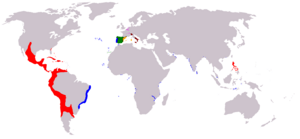Supreme Council of Flanders facts for kids

The Supreme Council of Flanders and Burgundy was an important group in the Spanish Empire. Its main job was to give advice to the King of Spain. This advice was about how to rule the Spanish Netherlands.
The Spanish Netherlands was a large area. It included most of modern-day Belgium and Luxembourg. It also covered parts of northern France, the southern Netherlands, and western Germany. The Council helped the king with many things. This included choosing church leaders and appointing important officials. They also advised on giving out royal pardons and special awards. These awards could be knighthoods or noble titles.
Contents
How Did the Council Start and End?
The Supreme Council of Flanders first began in 1588. This was during the rule of Philip II of Spain. But when Philip II died, the Council was closed down. The Spanish Netherlands then came under the rule of Albert VII of Austria. He ruled with his wife, Isabella Clara Eugenia.
The Council was started again in 1627. This time, it was under Philip IV of Spain. It continued to advise the king for many years. However, the Council was finally ended in 1702. Today, the old records of the Council are kept safe. You can find them in the Archivo General de Simancas in Spain.
Who Was in the Council?
When the Council was restarted in 1627, it was planned to have six main members. Two secretaries would also help them. Three of the members were supposed to be legal experts, called jurists. The other three members were from important noble families. At least one member had to be from the Low Countries (the Spanish Netherlands). One of the noblemen would act as the president, leading the Council. However, the Council rarely had all its members at full strength.
Important Leaders: Presidents
The president was the main leader of the Council. Here are some of the people who held this important role:
- Diego Felipez de Guzmán, 1st Marquis of Leganés, from 1628 to 1653
- Filippo Spinola, 2nd Marquis of the Balbases, from 1653 to 1659
- Antonio Sancho Dávila de Toledo y Colonna, from 1660 to 1666
Important Helpers: Secretaries
The secretaries helped the Council by managing documents and communications. They played a key role in making sure everything ran smoothly. Some of the secretaries included:
- Gabriel de Roy, a knight, from 1627 to 1645
- Jean Hernart, from 1627 to 1631
- Juan Osvaldo de Brito, from 1628 to 1637
- Jacques Brecht, from 1638 to 1660
- Jean Vecquer, also known as Weckert, from 1660 to 1673
See also
 In Spanish: Consejo de Flandes para niños
In Spanish: Consejo de Flandes para niños

